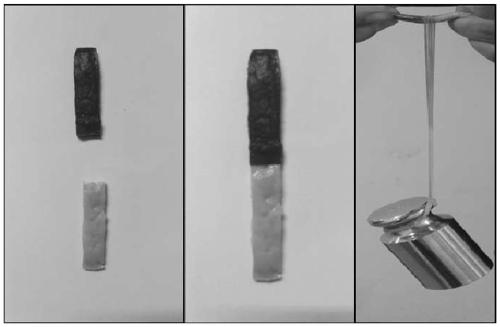Self-healing hydrogel and preparation method thereof
A hydrogel and self-healing technology, applied in the field of self-healing hydrogel and its preparation, can solve problems such as lack of self-healing properties, achieve good self-healing effect, simple healing conditions, and super mechanical performance effect
- Summary
- Abstract
- Description
- Claims
- Application Information
AI Technical Summary
Problems solved by technology
Method used
Image
Examples
Embodiment 1
[0019] Firstly, 3 g of isopropylacrylamide, 10 mL of water, and 20 mL of nano-silica sol were uniformly mixed, stirred for 10 min, and ultrasonicated for 30 min to uniformly disperse the nano-silica particles in the solution. Add 80 mg of ammonium persulfate and 150 μL of N,N,N,N-tetramethylethylenediamine, and stir until the solution is uniform and stable. Stand in an oven at 60°C for 30 minutes, then soak in 1mol / L sodium hydroxide solution, and stir gently to fully soak and strengthen the material. Compress the cross-linked gel in a mold. After drying at room temperature for 15 days, a self-healing hydrogel with super-strong mechanical properties was obtained. Such as figure 1 As shown, the self-healing hydrogel was subjected to a shear test using a universal compression testing machine, and the section was soaked in 75% ethanol solution, and after splicing together, it was dried at room temperature for 15 days. A universal testing machine was used to test the shear stre...
Embodiment 2
[0021] Firstly, 3g of isopropylacrylamide, 10mL of water, and 15mL of nano-silica sol were uniformly mixed, stirred for 10 minutes, and ultrasonicated for 30 minutes to evenly disperse the nano-silica particles in the solution. Add 60 mg of ammonium persulfate and 150 μL of N,N,N,N-tetramethylethylenediamine, and stir until the solution is uniform and stable. Stand in an oven at 60°C for 30 minutes. Take out the sample, soak it in 1mol / L sodium hydroxide solution to obtain the colloid, then extrude the colloid into a mold, and dry it at room temperature for 10-15 days to obtain a self-healing hydrogel with super strong mechanical properties. Such as figure 1 As shown, the above self-healing hydrogel was subjected to a shear test using a universal compression testing machine, and the section was soaked in 75% ethanol solution, and after being spliced together, it was dried at room temperature for 15 days. A universal testing machine was used to test the shear stress of the ...
Embodiment 3
[0023] Firstly, 3g of isopropylacrylamide, 15mL of water, and 15mL of nano-silica sol were uniformly mixed, stirred for 10 minutes, and ultrasonicated for 30 minutes to uniformly disperse the nano-silica particles in the solution. Add 60 mg of ammonium persulfate and 150 μL of N,N,N,N-tetramethylethylenediamine, and stir until the solution is uniform and stable. Stand in an oven at 60°C for 30 minutes. Take out the sample, soak it in 1mol / L sodium hydroxide solution to obtain the colloid, then extrude the colloid into a mold, and dry it at room temperature for 10-15 days to obtain a self-healing hydrogel with super strong mechanical properties. Such as figure 1 As shown, the above self-healing hydrogel was subjected to a shear test using a universal compression testing machine. The cross-section was soaked in an aqueous solution, and after being spliced together, it was dried at room temperature for 15 days. A universal testing machine was used to test the shear stress of ...
PUM
| Property | Measurement | Unit |
|---|---|---|
| particle diameter | aaaaa | aaaaa |
| particle diameter | aaaaa | aaaaa |
Abstract
Description
Claims
Application Information
 Login to View More
Login to View More - R&D
- Intellectual Property
- Life Sciences
- Materials
- Tech Scout
- Unparalleled Data Quality
- Higher Quality Content
- 60% Fewer Hallucinations
Browse by: Latest US Patents, China's latest patents, Technical Efficacy Thesaurus, Application Domain, Technology Topic, Popular Technical Reports.
© 2025 PatSnap. All rights reserved.Legal|Privacy policy|Modern Slavery Act Transparency Statement|Sitemap|About US| Contact US: help@patsnap.com

